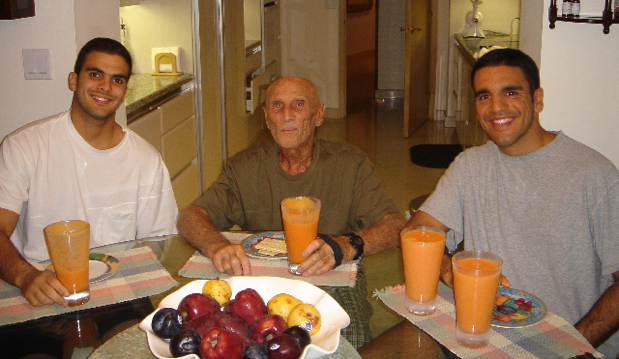
The History and Principles of the Jujutsu Nutrition Regimen
The Jujutsu Nutrition Regimen is a proven path to good health. Just like jujutsu, it is efficient, flexible and easy to learn. An improvement in wellness and overall energy level is often felt within the first few weeks of its adoption.
History
Healthy nutrition has been a part of jujutsu training since the time of the samurai warriors in Japan. When jujutsu masters brought the art from Japan to the western world in the beginning of the 20th century, they promoted healthy eating, staying away from alcohol and smoking, among other recommendations.
Inspired by his teacher Grand Master Mitsuyo Maeda, Grand Master Carlos Gracie dedicated 65 years of his life to the committed research and experimentation of nutrition. He promoted an eating regimen based on selecting natural foods that do not poison the body and combining them in ways that allow for an efficient digestion. Thousands have benefited from this nutrition regimen including the late Grand Master Hélio Gracie, who credited it with his longevity and ability to continue his daily jujutsu training until the age of 95.
Dr. Pedro Valente (senior), plastic surgeon and Jujutsu Grand Master Red Belt 9th Dan, graduated from Medical school in 1963 and aside from a specialization in plastic surgery he also dedicated himself to the study of nutrition.
As a surgeon he applied the nutrition regimen to his pre-surgery and recovery patients in his plastic surgery clinic, becoming a pioneer in the field. At that time, Carlos Gracie and Pedro Valente would share their knowledge and scientific findings in nutrition and hygiene to improve their practices. They maintained this exchange of information and experiments until Carlos passed away in the 1990’s.
Dr. Pedro Valente Sr. continued to apply Carlos Gracie’s teachings not only with his patients, but also with athletes. Dr. Valente introduced the principles of the jujutsu nutrition regimen to one of the world’s most recognized football (soccer) teams, Vasco da Gama. Soccer legend Romario credited the regimen, which was prescribed to him by Dr. Valente for his unprecedented feat of becoming the lead scorer in the Brazilian Soccer league at the age of 40 in 2006. Today many professional teams have adopted several of Dr. Valente’s innovative methods in the training and nutrition of their athletes.
How it works
The food combining system is simple and easy to understand. It rationally evolved from the study of gastric physiology and the actions of enzymes and digestive juices. Hygienic food selection and the principles of food combining are based on the nutritional needs of humans and the limitations of our digestive systems. It is not what we eat, but what we digest and assimilate, that determines the health of our bodies. Food combining is based on the understanding that certain combinations of food may be digested more efficiently than others. The idea is to save precious energy that can be used in other vital physiological activities.
Proper food combining results in an immediate improvement in physical and mental health by easing the digestive process. As a result you will experience better nutrition, better digestion, less fermentation and putrefaction, more comfort, less distress and less gas. Fermentation causes irritation and poisoning. Proper food combining removes fermentation as a cause of indigestion. Other conditions that cause indigestion include overeating; eating hurriedly or when tired, worried, angry, fearful, grieved, etc.; or when you are in pain or have a fever or inflammation).
The successful results obtained through the utilization of this nutrition regimen can be explained and substantiated by the study of gastric physiology, and the chemistry of digestion.
Principles
• Digestion consumes a lot of energy – The jujutsu nutrition regimen is based on the principle that digestion is the body’s most strenuous daily activity and that properly combining foods significantly eases digestion and enables the body to employ a maximum percentage of its resources in other indispensable activities like training, healing injuries, fighting disease, etc.
• Different Foods Require Specific Digestive Enzymes – Specific digestive enzymes are needed to digest different types of foods. Foods can be grouped according to the digestive enzymes needed to break them down. Combining foods properly prevents indigestion and enhances general health.
• Allow Time for Recovery Between Meals – One should allow four and a half hours between meals. This allows the body to finish its job, recover, and return to its neutral state before having to produce another set of digestive enzymes.
• Pick the right foods – Make high quality food a priority. Pick foods that are highly nutritive and easy to digest and stay away from packaged foods with chemical additives.
• Don’t Overeat – Eating too much overloads the body’s digestive system. Always leave the table feeling like you could eat more.
• Eat slowly, chew your food thoroughly – Ideally, chew your food until it is liquid. Your saliva has enzymes that facilitate digestion. Also, it is easier to digest small particles than large ones. Not chewing well stresses your digestive system and can lead to poor absorption of nutrients, digestive problems like gas and bloating and promote the growth of harmful bacteria in the digestive tract.

